The Spatial-Temporal Characteristics of Cultivated Land and Its Influential Factors in The Low Hilly Region: A Case Study of Lishan Town, Hubei Province, China
Abstract
1. Introduction
2. Study Area and Data Sources
3. Methods
3.1. Kernel Density Estimation (KDE)
3.2. Global Spatial Autocorrelation Analysis
3.3. Local Spatial Autocorrelation Analysis
3.4. Spatial Weight Matrix
3.5. Topographic Position Index
3.6. Spatial Autoregressive Model
4. Results and Analysis
4.1. Distribution and Variation Characteristics of Regional Cultivated Land
4.2. Kernel Density Analysis of Cultivated Land
4.3. Analysis of Autocorrelation in Cultivated Land
4.3.1. Global Spatial Autocorrelation
4.3.2. Local Spatial Autocorrelation
4.4. Spatial Autocorrelation Regression Analysis of Influencing Factors of Cultivated Land
4.4.1. Selection of the Model
4.4.2. Analysis of Regression Results
5. Conclusions and Discussion
Author Contributions
Acknowledgments
Conflicts of Interest
References
- Tanrivermis, H. Agricultural land use change and sustainable use of land resources in the Mediterranean region of Turkey. J. Arid Environ. 2003, 54, 553–564. [Google Scholar] [CrossRef]
- Song, W.; Pijanowski, B.C. The effects of China’s cultivated land balance program on potential land productivity at a national scale. Appl. Geogr. 2014, 46, 158–170. [Google Scholar] [CrossRef]
- Zhao, W.W. Arable land change dynamics and their driving forces for the major countries of the world. Acta Ecol. Sin. 2012, 32, 6452–6462. [Google Scholar] [CrossRef]
- The Statistical Database of the Food and Agriculture Organization (FAO). Available online: http://www.fao.org (accessed on 15 June 2019).
- EL-kawy, O.R.A.; Ismail, H.A.; Yehia, H.M.; Allam, M.B. Temporal detection and prediction of agricultural land consumption by urbanization using remote sensing. Egypt. J. Remote Sens. Space Sci. 2019. [Google Scholar] [CrossRef]
- Radwan, T.M.; Blackburn, G.A.; Whyatt, J.D.; Atkinson, P.M. Dramatic Loss of Agricultural Land Due to Urban Expansion Threatens Food Security in the Nile Delta, Egypt. Remote Sens. 2019, 11, 332. [Google Scholar] [CrossRef]
- Szewrański, S.; Kazak, J.; Żmuda, R.; Wawer, R. Indicator-based assessment for soil resource management in the Wrocław Larger Urban Zone of Poland. Pol. J. Environ. Stud. 2017, 26, 2239–2248. [Google Scholar] [CrossRef]
- Deng, X.Z.; Huang, J.K.; Scott, R.; Zhang, J.P.; Li, Z.H. Impact of urbanization on cultivated land changes in China. Land Use Policy 2015, 45, 1–7. [Google Scholar] [CrossRef]
- The Ministry of Natural Resources of the People’s Republic of China. Available online: http://www.mnr.gov.cn/dt/ywbb/201810/t20181030_2290463.html (accessed on 18 May 2018).
- Xie, Y.C.; Mei, Y.; Guang, J.T.; Xue, R.X. Socio-economic driving forces of arable land conversion: A case study of Wuxian City, China. Glob. Environ. Chang. 2005, 15, 238–252. [Google Scholar] [CrossRef]
- Tan, Y.T.; Xu, H.; Zhang, X.L. Sustainable urbanization in China: A comprehensive literature review. Cities 2016, 55, 82–93. [Google Scholar] [CrossRef]
- Zu, J.; Hao, J.M.; Chen, L.; Zhang, Y.B.; Wang, J.; Kang, L.T.; Guo, S.H. Analysis on trinity connotation and approach to protect quantity, quality and ecology of cultivated land. J. China Agric. Univ. 2018, 23, 84–95. [Google Scholar]
- The Milnistry of Nature Resources of the People’s Repulic of China. Available online: http://f.mlr.gov.cn/201712/t20171214_1702106.html (accessed on 11 December 2018).
- Liu, T.; Liu, H.; Qi, Y.J. Construction land expansion and cultivated land protection in urbanizing China: Insights from national land surveys, 1996–2006. Habitat Int. 2015, 46, 13–22. [Google Scholar] [CrossRef]
- Xie, H.L.; Wang, W.; Zhang, X.M. Evolutionary game and simulation of management strategies of fallow cultivated land: A case study in Hunan province, China. Land Use Policy 2018, 71, 86–97. [Google Scholar] [CrossRef]
- Liu, X.W.; Zhao, C.L.; Song, W. Review of the evolution of cultivated land protection policies in the period following China’s reform and liberalization. Land Use Policy 2017, 67, 660–669. [Google Scholar] [CrossRef]
- Liu, Y.S.; Wang, J.Y.; Long, H.L. Analysis of arable land loss and its impact on rural sustainability in Southern Jiangsu Province of China. J. Environ. Manag. 2010, 91, 646–653. [Google Scholar] [CrossRef] [PubMed]
- Rounsevell, M.D.A.; Annetts, J.E.; Audsley, E.; Mayr, T.; Reginster, I. Modelling the spatial distribution of agricultural land use at the regional scale. Agric. Ecosyst. Environ. 2003, 95, 465–479. [Google Scholar] [CrossRef]
- Chen, J.F.; Wei, S.Q.; Chang, K.T.; Tsai, B.W. A comparative case study of cultivated land changes in Fujian and Taiwan. Land Use Policy 2007, 24, 386–395. [Google Scholar] [CrossRef]
- Huang, B.Q.; Huang, J.L.; Pontius, R.G., Jr.; Tu, Z.S. Comparison of Intensity Analysis and the land use dynamic degrees to measure land changes outside versus inside the coastal zone of Longhai, China. Ecol. Indic. 2018, 89, 336–347. [Google Scholar] [CrossRef]
- Li, X.; Yeh, A.G.O. Modelling sustainable urban development by the integration of constrained cellular automata and GIS. Int. J. Geogr. Inf. Sci. 2000, 14, 131–152. [Google Scholar] [CrossRef]
- Zhong, T.Y.; Huang, X.J.; Zhang, X.Y.; Wang, K. Temporal and spatial variability of agricultural land loss in relation to policy and accessibility in a low hilly region of southeast China. Land Use Policy 2011, 28, 762–769. [Google Scholar] [CrossRef]
- Li, H.; Wu, Y.Z.; Huang, X.J.; Sloan, M.; Skitmore, M. Spatial-temporal evolution and classification of marginalization of cultivated land in the process of urbanization. Habitat Int. 2017, 61, 1–8. [Google Scholar] [CrossRef]
- Xie, H.L.; Yao, G.R.; Liu, G.Y. Spatial evaluation of the ecological importance based on GIS for environmental management: A case study in Xingguo county of China. Ecol. Indic. 2015, 51, 3–12. [Google Scholar] [CrossRef]
- Hua, Y.; Yan, M.; Li, M.D. Land ecological security assessment for Bai autonomous prefecture of Dali based using PSR model—With data in 2009 as case. Energy Procedia 2011, 5, 2172–2177. [Google Scholar] [CrossRef]
- Liang, W.; Yang, Y.T.; Fan, D.M.; Guan, H.D.; Zhang, T.; Long, D.; Zhou, Y.; Bai, D. Analysis of spatial and temporal patterns of net primary production and their climate controls in China from 1982 to 2010. Agric. For. Meteorol. 2015, 204, 22–36. [Google Scholar] [CrossRef]
- Long, H.L.; Liu, Y.S.; Wu, X.Q.; Dong, G.H. Spatio-temporal dynamic patterns of farmland and rural settlements in Su–Xi–Chang region: Implications for building a new countryside in coastal China. Land Use Policy 2009, 26, 322–333. [Google Scholar] [CrossRef]
- Liu, J.Y.; Zhang, Z.X.; Xu, X.L.; Kuang, W.H.; Zhou, W.C.; Zhang, S.W.; Li, R.D.; Yan, C.Z.; Yu, D.S.; Wu, S.X.; et al. Spatial patterns and driving forces of land use change in China during the early 21st century. J. Geogr. Sci. 2010, 20, 483–494. [Google Scholar] [CrossRef]
- Han, H.R.; Yang, C.F.; Song, J.P. Scenario simulation and the prediction of land use and land cover change in Beijing, China. Sustainability 2015, 7, 4260–4279. [Google Scholar] [CrossRef]
- Yu, J.; Ning, J.; Dong, F.C.; Du, G.M.; Lou, G.; Zhao, Z. Distribution and evolutionary characteristics of cultivated lands in the north-east of Sanjiang Plain from 1950 to 2013. J. Arid Land Resour. Environ. 2017, 31, 79–86. [Google Scholar]
- Xie, B.G.; Zeng, X.M.; Li, X.Q.; Deng, C.X.; Zhu, D.G. Research spatial layout optimization of rural residential land in land use planning at township—A case of Liaotian town in Hengnan county. Econ. Geogr. 2010, 10, 1700–1706. [Google Scholar]
- Wang, H.; Long, H.L.; Li, X.B.; Yu, F. Evaluation of changes in ecological security in China’s Qinghai Lake Basin from 2000 to 2013 and the relationship to land use and climate change. Environ. Earth Sci. 2014, 72, 341–354. [Google Scholar] [CrossRef]
- Zhang, W.T.; Huang, B. Land use optimization for a rapidly urbanizing city with regard to local climate change: Shenzhen as a case study. J. Urban Plan. Dev. 2014, 141, 05014007. [Google Scholar] [CrossRef]
- Liu, J.Y.; Liu, M.L.; Tian, H.Q.; Zhuang, D.F.; Zhang, Z.X.; Zhang, W.; Tang, X.M.; Deng, X.Z. Spatial and temporal patterns of China’s cropland during 1990–2000: An analysis based on Landsat TM data. Remote Sens. Environ. 2005, 98, 442–456. [Google Scholar] [CrossRef]
- Zheng, Y.M.; Chen, T.B.; He, J.Z. Multivariate geostatistical analysis of heavy metals in topsoils from Beijing, China. J. Soils Sediment 2008, 8, 51–58. [Google Scholar] [CrossRef]
- Sun, B.; Zhou, S.L.; Zhao, Q.G. Evaluation of spatial and temporal changes of soil quality based on geostatistical analysis in the hill region of subtropical China. Geoderma 2003, 115, 85–99. [Google Scholar] [CrossRef]
- Li, X.; Yeh, A.G.O. Analyzing spatial restructuring of land use patterns in a fast growing region using remote sensing and GIS. Landsc. Urban Plan. 2004, 69, 335–354. [Google Scholar] [CrossRef]
- Gao, J.; Liu, Y.S.; Chen, Y.F. Land cover changes during agrarian restructuring in Northeast China. Appl. Geogr. 2006, 26, 312–322. [Google Scholar] [CrossRef]
- The Bureau of Land Resource Suizhou. Available online: http://www.szgtzy.gov.cn/ (accessed on 2 August 2018).
- The Bureau of Land Resource Suixian. Available online: http://www.zgsuixian.gov.cn/sxgt/ (accessed on 25 June 2018).
- Rinner, C.; Hussain, M. Toronto’s urban heat island—Exploring the relationship between land use and surface temperature. Remote Sens. 2011, 3, 1251–1265. [Google Scholar] [CrossRef]
- Lanorte, A.; Danese, M.; Lasaponara, R.; Murgante, B. Multiscale mapping of burn area and severity using multisensor satellite data and spatial autocorrelation analysis. Int. J. Appl. Earth Obs. Int. 2013, 20, 42–51. [Google Scholar] [CrossRef]
- Griffith, D.A. Visualizing analytical spatial autocorrelation components latent in spatial interaction data: An eigenvector spatial filter approach. Comput. Environ. Urban 2011, 35, 140–149. [Google Scholar] [CrossRef]
- Diniz-Filho, J.A.F.; Siqueira, T.; Padial, A.A.; Rangel, T.F.; Landeiro, V.L.; Bini, L.M. Spatial autocorrelation analysis allows disentangling the balance between neutral and niche processes in metacommunities. Oikos 2012, 121, 201–210. [Google Scholar] [CrossRef]
- Oliveira, D.G.; Diniz-Filho, J.A.F. Spatial patterns of terrestrial vertebrate richness in Brazilian semiarid, Northeastern Brazil: Selecting hypotheses and revealing constraints. J. Arid Environ. 2010, 74, 1418–1426. [Google Scholar] [CrossRef]
- Kawaguchi, D.; Yukutake, N. Estimating the residential land damage of the Fukushima kernel accident. J. Urban Econ. 2017, 99, 148–160. [Google Scholar] [CrossRef]
- Fleming, C.H.; Calabrese, J.M. A new kernel density estimator for accurate home-range and species-range area estimation. Methods Ecol. Evol. 2017, 8, 571–579. [Google Scholar] [CrossRef]
- Nourani, V.; Zanardo, S. Wavelet-based regularization of the extracted topographic index from high-resolution topography for hydro-geomorphic applications. Hydrol. Process. 2014, 28, 1345–1357. [Google Scholar] [CrossRef]
- Feng, Z.; Chen, W. Environmental regulation, green innovation, and industrial green development: An empirical analysis based on the Spatial Durbin model. Sustainability 2018, 10, 223. [Google Scholar] [CrossRef]
- Dai, Z.; Guldmann, J.M.; Hu, Y.F. Spatial regression models of park and land-use impacts on the urban heat island in central Beijing. Sci. Total Environ. 2018, 626, 1136–1147. [Google Scholar] [CrossRef] [PubMed]
- Khaledian, Y.; Kiani, F.; Ebrahimi, S.; Brevik, E.C.; Aitkenhead-Peterson, J. Assessment and monitoring of soil degradation during land use change using multivariate analysis. Land Degrad. Dev. 2017, 28, 128–141. [Google Scholar] [CrossRef]
- De Beurs, K.M.; Henebry, G.M. Land surface phenology, climatic variation, and institutional change: Analyzing agricultural land cover change in Kazakhstan. Remote Sens. Environ. 2004, 89, 497–509. [Google Scholar] [CrossRef]
- LeSage, J.; Pace, R.K. Introduction to Spatial Econometrics; Chapman and Hall: New York, NY, USA; CRC: New York, NY, USA, 2009. [Google Scholar]
- Zhang, R.; Du, Q.Y.; Geng, J.J.; Liu, B.; Huang, Y.K. An improved spatial error model for the mass appraisal of commercial real estate based on spatial analysis: Shenzhen as a case study. Habitat Int. 2015, 46, 196–205. [Google Scholar] [CrossRef]
- Overmars, K.D.; De Koning, G.H.J.; Veldkamp, A. Spatial autocorrelation in multi-scale land use models. Ecol. Model. 2003, 164, 257–270. [Google Scholar] [CrossRef]
- Ku, C.A. Incorporating spatial regression model into cellular automata for simulating land use change. Appl. Geogr. 2016, 69, 1–9. [Google Scholar] [CrossRef]
- Zhang, X.S.; He, J.; Deng, Z.; Ma, J.Y.; Chen, G.P.; Zhang, M.M.; Li, D.S. Comparative Changes of Influence Factors of Rural Residential Area Based on Spatial Econometric Regression Model: A Case Study of Lishan Township, Hubei Province, China. Sustainability 2018, 10, 3403. [Google Scholar] [CrossRef]
- Chun, B.; Guldmann, J.M. Spatial statistical analysis and simulation of the urban heat island in high-density central cities. Landsc. Urban Plan. 2014, 125, 76–88. [Google Scholar] [CrossRef]
- Anselin, L. Spatial Econometrics: Methods and Models; Kluwer Academic Press: Philip Drive Norwell, MA, USA, 1988. [Google Scholar]
- Anselin, L.; Florax, R.; Rey, S.J. Advances in Spatial Econometrics: Methodology, Tools and Applications; Springer: New York, NY, USA, 2004. [Google Scholar]
- Anselin, L. Spatial Externalities, Spatial Multipliers, and Spatial Econometrics. Int. Reg. Sci. Rev. 2003, 26, 153–166. [Google Scholar] [CrossRef]
- Anselin, L.; Bera, A. Spatial dependence in linear regression models with an introduction to spatial econometrics. In Handbook of Applied Economic Statistics; Ullah, A., Giles, D., Eds.; Marcel Dekker: New York, NY, USA, 1998. [Google Scholar]
- Yao, Y.M.; Zhu, X.D.; Xu, Y.B.; Yang, H.Y.; Wu, X.; Li, Y.F.; Zhang, Y.F. Assessing the visual quality of green landscaping in rural residential areas: The case of Changzhou, China. Environ. Monit. Assess. 2012, 184, 951–967. [Google Scholar] [CrossRef] [PubMed]
- Ren, P.; Hong, K.; Zhou, J.M. Research on spatio-temporal evolution and characteristics of rural settlements based on spatial autocorrelation model. Resour. Environ. Yangtze River Basin 2015, 24, 1993–2002. [Google Scholar]
- Yu, S.Y.; Xu, Z.X.; Wu, W.; Zuo, D.P. Effect of land use types on stream water quality under seasonal variation and topographic characteristics in the Wei River basin, China. Ecol. Indic. 2016, 60, 202–212. [Google Scholar] [CrossRef]
- Luo, C.; Cai, Y.Y. The stage characteristics and spatial heterogeneity of cultivated land resource function evolution in agricultural producing areas of Hubei Province. Econ. Geogr. 2016, 36, 153–161. [Google Scholar]
- Wang, G.M.; Chen, C.; Cao, G.Q.; Yi, Z.Y. Spatial-temporal characteristics and influential factors decomposition of farmland transfer in China. Trans. Chin. Soc. Agric. Eng. 2017, 33, 1–7. [Google Scholar]
- Quan, B.; Chen, J.F.; Qiu, H.L.; Romkens, M.J.M.; Yang, X.Q.; Jiang, S.F.; Li, B.C. Spatial-temporal pattern and driving forces of land use changes in Xiamen. Pedoshere 2006, 16, 477–488. [Google Scholar] [CrossRef]
- Liu, Y.S.; Wang, J.F.; Guo, L.Y. The Spatial-temporal changes of grain production and arable land in China. Sci. Agric. Sin. 2009, 42, 4269–4274. [Google Scholar]

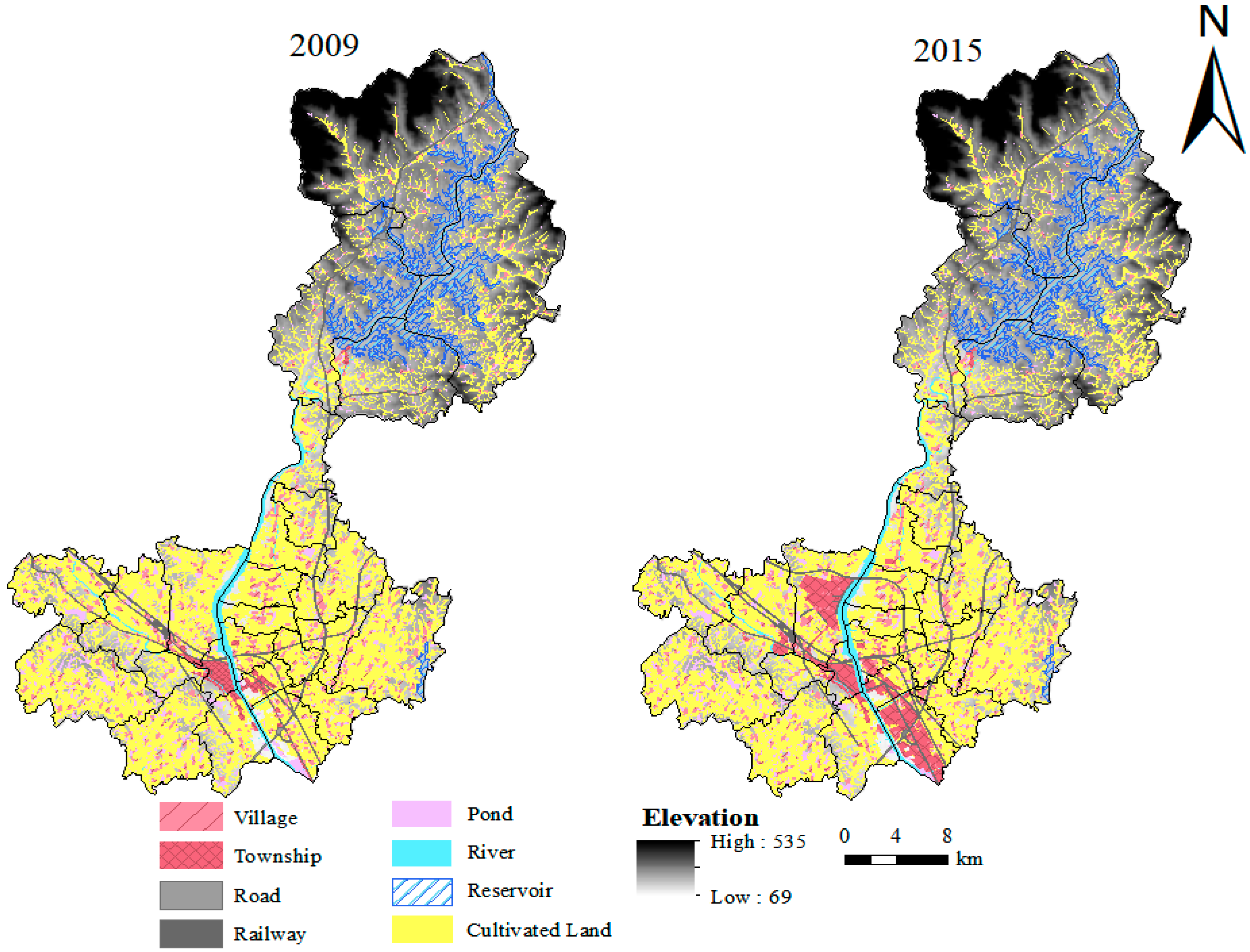
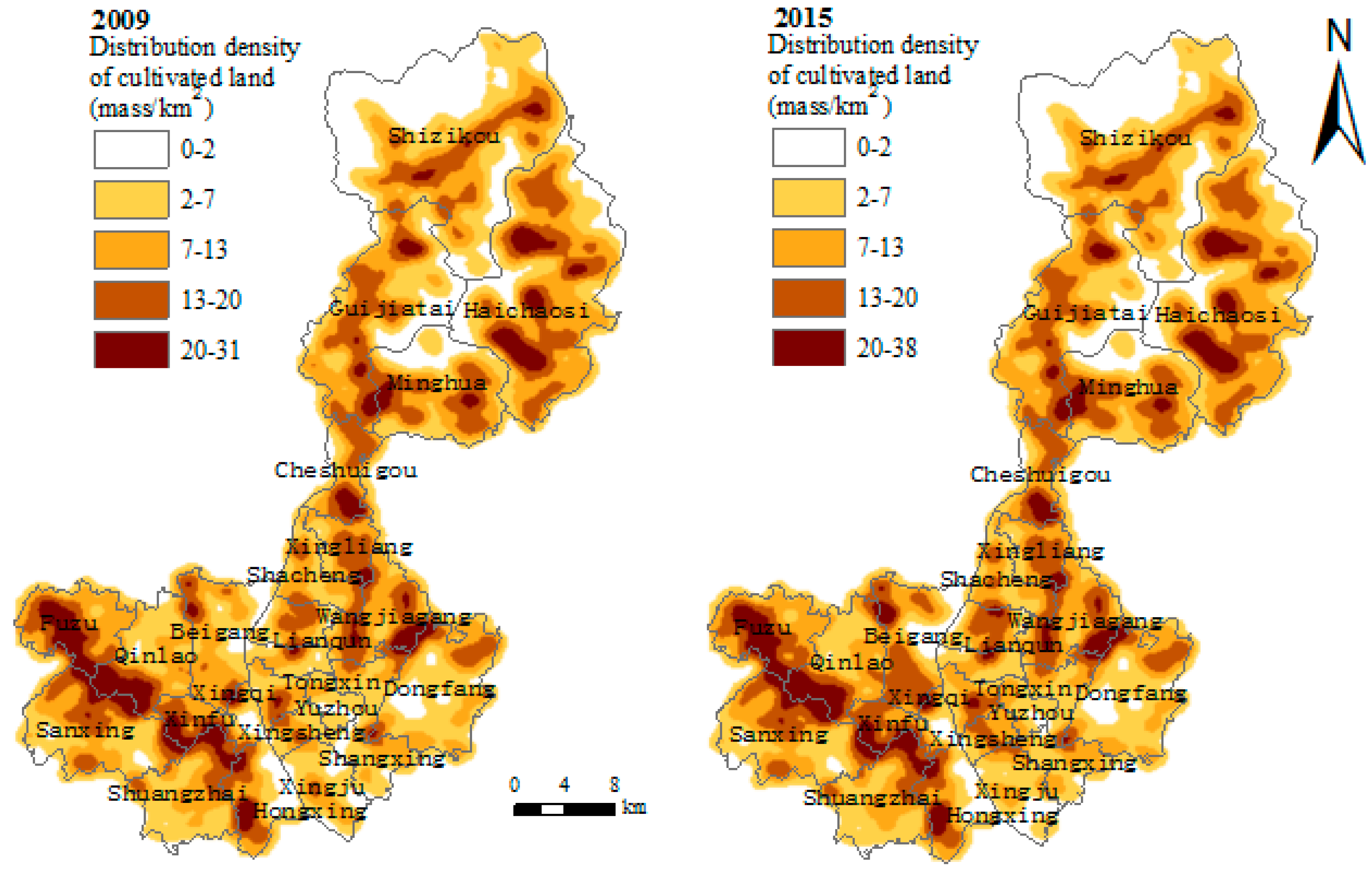
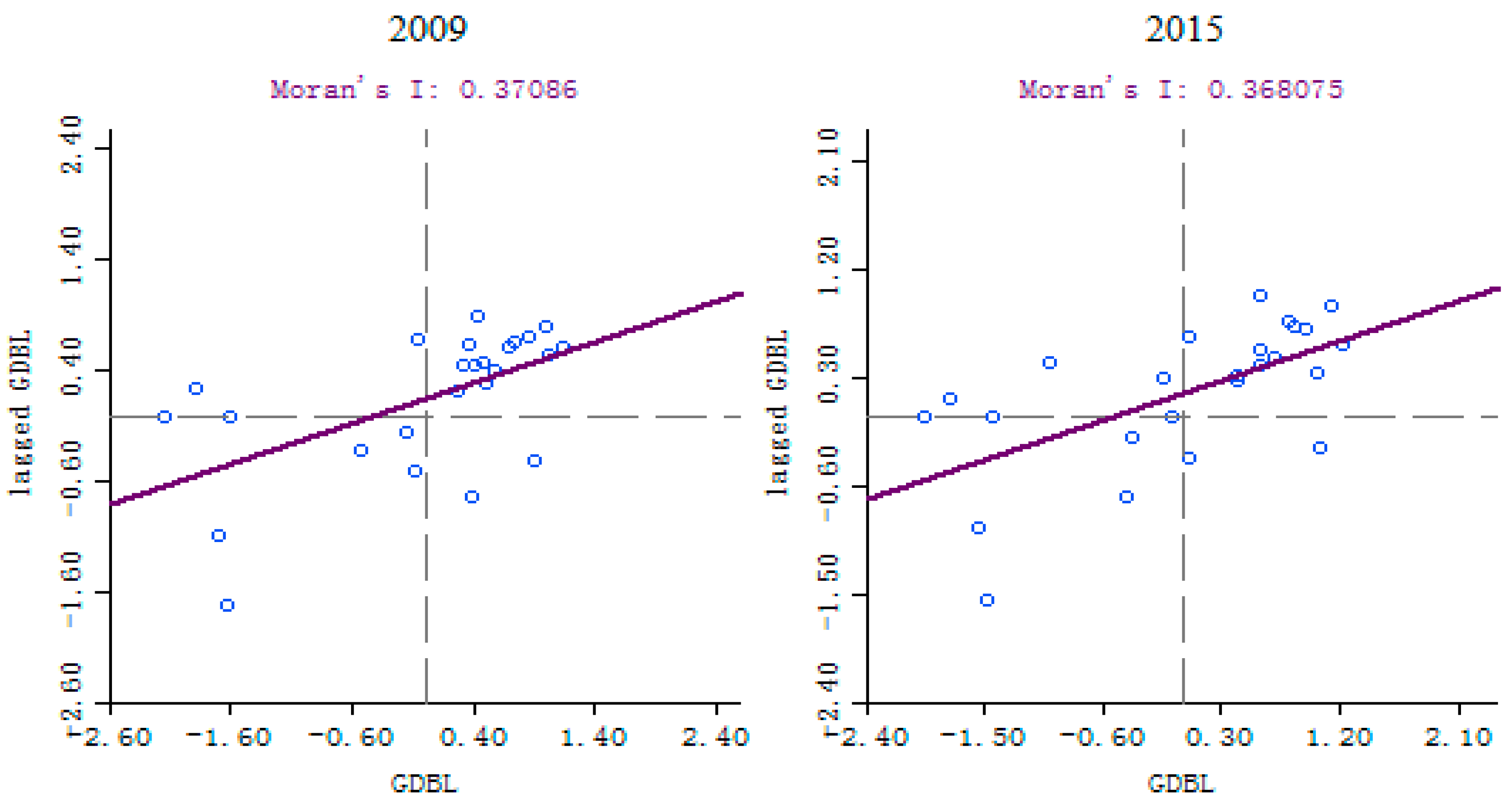
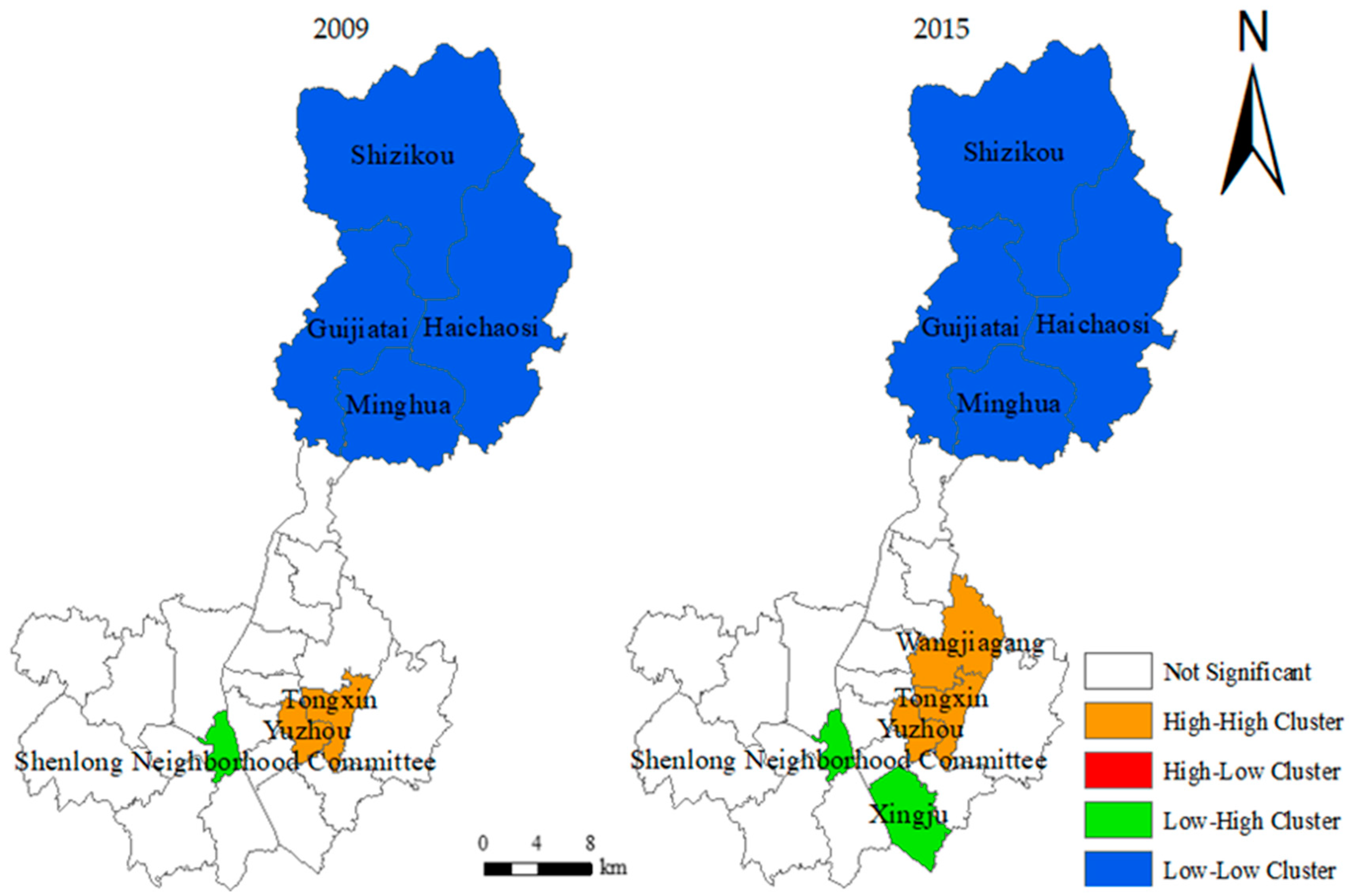
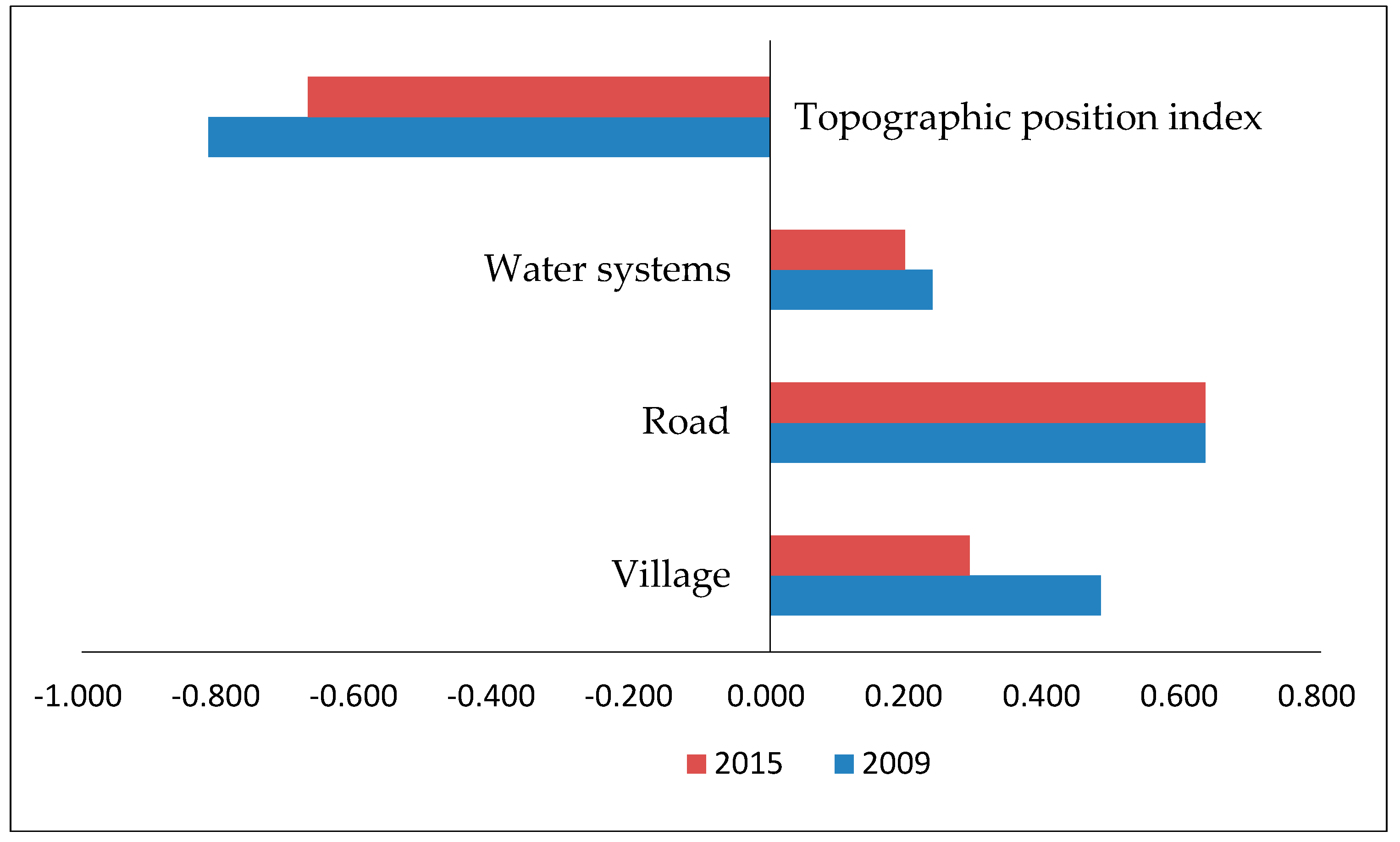
| Year | Moran’s I | Zscore | |
|---|---|---|---|
| 2009 | 0.5251 | 6.343 | 1.96 |
| 2015 | 0.3970 | 4.820 | 1.96 |
| Test | 2009 | 2015 | ||||
|---|---|---|---|---|---|---|
| MI/DF | Value | p | MI/DF | Value | p | |
| Langrange Multiplier(lag) | 1 | 119.417 | 0.000 | 1 | 25.510 | 0.000 |
| Robust LM(lag) | 1 | 27.134 | 0.000 | 1 | 0.973 | 0.410 |
| Langange Multiplier(error) | 1 | 175.289 | 0.000 | 1 | 58.156 | 0.000 |
| Robust LM(error) | 1 | 67.158 | 0.000 | 1 | 32.754 | 0.000 |
| Item | 2009 | 2015 | ||||||
|---|---|---|---|---|---|---|---|---|
| Variables | Coefficient | Standard Deviation | Z-Value | p | Coefficient | Standard Deviation | Z-Value | p |
| Constant | −20.095 | 0.904 | −22.223 | 0.000 | −19.134 | 0.789 | −24.249 | 0.000 |
| To the nearest village | 0.236 | 0.083 | 11.096 | 0.000 | 0.196 | 0.081 | 2.424 | 0.000 |
| To the nearest road | 0.632 | 0.057 | 11.096 | 0.000 | 0.630 | 0.056 | 11.288 | 0.000 |
| To the nearest water systems | 0.481 | 0.099 | 4.855 | 0.000 | 0.290 | 0.080 | 3.610 | 0.015 |
| Topographic position index | −0.817 | 0.206 | −3.957 | 0.005 | −0.672 | 0.202 | −3.332 | 0.001 |
| LAMBDA | 0.796 | 0.069 | 11.485 | 0.000 | 0.828 | 0.063 | 13.076 | 0.000 |
© 2019 by the authors. Licensee MDPI, Basel, Switzerland. This article is an open access article distributed under the terms and conditions of the Creative Commons Attribution (CC BY) license (http://creativecommons.org/licenses/by/4.0/).
Share and Cite
Zhang, X.; Zhang, M.; He, J.; Wang, Q.; Li, D. The Spatial-Temporal Characteristics of Cultivated Land and Its Influential Factors in The Low Hilly Region: A Case Study of Lishan Town, Hubei Province, China. Sustainability 2019, 11, 3810. https://doi.org/10.3390/su11143810
Zhang X, Zhang M, He J, Wang Q, Li D. The Spatial-Temporal Characteristics of Cultivated Land and Its Influential Factors in The Low Hilly Region: A Case Study of Lishan Town, Hubei Province, China. Sustainability. 2019; 11(14):3810. https://doi.org/10.3390/su11143810
Chicago/Turabian StyleZhang, Xuesong, Maomao Zhang, Ju He, Quanxi Wang, and Deshou Li. 2019. "The Spatial-Temporal Characteristics of Cultivated Land and Its Influential Factors in The Low Hilly Region: A Case Study of Lishan Town, Hubei Province, China" Sustainability 11, no. 14: 3810. https://doi.org/10.3390/su11143810
APA StyleZhang, X., Zhang, M., He, J., Wang, Q., & Li, D. (2019). The Spatial-Temporal Characteristics of Cultivated Land and Its Influential Factors in The Low Hilly Region: A Case Study of Lishan Town, Hubei Province, China. Sustainability, 11(14), 3810. https://doi.org/10.3390/su11143810






